I thought I might add some photos I have taken of various leaf markings on Cymbidium leaves and their causes in order to help others diagnose possible problems with their plants. I have updated this entry a few times as more information has become available to me and I've taken more photos. All virus testing has been done by the DPIPWE lab in Tasmania, Australia.
Insect Damage
The particular plant shown in this photo had a few scale insects on it when I obtained it (apparently the grower had had a bad season for scale). It tested negative for viruses.
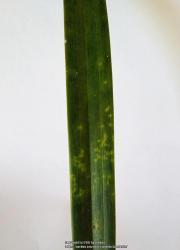
Scale insects tend to hide under the old leaf husks, so even if there are few (or none) elsewhere on the plant, it pays to remove the old husks and keep the plant clean. Otherwise you might end up with a serious problem! Here's one that I neglected for a while and eventually noticed a number of insects on the leaves, prompting me to clean it up. These scale insects had set up quite a colony under the dead leaf husks:
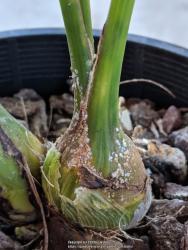
Mites can do damage to both the top and underside of leaves. The ones I have encountered most tend to feed on the underside of leaves and create a pattern of fine speckling. If this becomes widespread, the underside of the leaf takes on a white or silvery appearance. The first photo below shows heavy mite damage, whereas the second shows moderate.
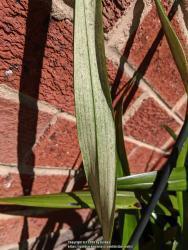
 Sunburn
Sunburn
This is the early stages of sunburn, which tends to occur on the highest point of the leaves (usually where they arch).
 Windburn
Windburn
Some species and hybrids, such as
Cym. erythrostylum and
Cym. dayanum, have tender foliage and if exposed to windy conditions, especially when humidity is low (which can happen in winter in Australia), the bulbs and foliage suffer windburn. The plant shown has
erythrostylum as one parent.
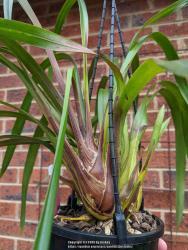 Water Quality Issues
Water Quality Issues
Some Cymbidium species are really fussy about their water quality (i.e
Cym. devonianum,
Cym. erythraeum,
Cym. iridioides and
Cym. tracyanum). They tend to suffer leaf tip dieback and necrotic spotting on the last part of the leaf. This particular plant is
iridioides; it tested negative for viruses. The grower remarked to me that this is a common issue with the species. Note that the leaf mottling is a separate issue and not likely to be related to water quality.
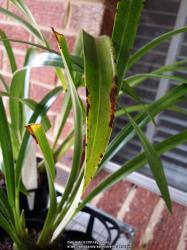
 Cold Damage
Cold Damage
Many of the traditional Cym species and hybrids will tolerate a light frost, but the warmer-growing species and hybrids will struggle with exposure to freezing temperatures. Below is an example of a
canaliculatum that suffered extreme cold damage whilst being shipped to me - it lost a number of leaves, much of the root system and one of the new growths dessicated and easily came away from the plant.


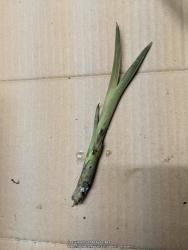 Environmental Mottling
Environmental Mottling (aka Chlorotic Bleaching)
It seems that temperatures on the extremes of what a Cymbidium can tolerate may induce leaf mottling. This is not temperatures that are hot enough to cook the plant or cold enough to freeze it, but close enough to the edge that they start to have a visible impact on the plant. C. Mausteller writes on
his blog about the impact of high temperatures on his Cymbidium collection; his
devonianum hybrids in particular showed similar mottling as a result of exposure to temperatures around 43-44°C. At this time, I am not sure if other factors can also cause these symptoms.
Both plants in these photos tested negative for viruses.

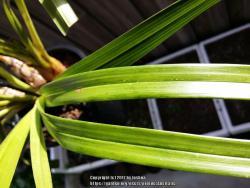 Hail Damage
Hail Damage
If you keep your plants outside and they are not protected from the elements, then depending on where you live you may eventually encounter hail damage. I only get serious hail once or twice a year; in the most recent case, all my plants that were not quite fully protected suffered leaf damage on the exposed side. Note in the photos where the hail has "chipped" away at the leaf surface (interestingly, very few leaves were actually bent or otherwise damaged).

 Odontoglossum Ringspot Virus (ORSV) Symptoms
Odontoglossum Ringspot Virus (ORSV) Symptoms
This is what ORSV can look like on a Cymbidium. I thought these photos were particularly important to include, as I have found it difficult to find good photos of ORSV symptoms online (perhaps because it can be variable). All of the plants pictured below tested positive for ORSV and were disposed of.
Chlorotic markings are a common symptom with ORSV. Note the chlorotic patch that is close to the end of each leaf in the first image below; the leaf on the left is showing the underside and has a much larger mark than on the leaf on the right. Occasionally the chlorotic markings are quite large, as shown in the second and third photos.



I typically find that only a small number of leaves exhibit necrotic markings as a result of ORSV (the severity of ORSV symptoms can vary significantly and in one case I had,
the plant was asymptomatic - which is more likely to occur if the plant is being well cared for). So far, the necrotic marks have followed a trend of being linear and running down the middle of one half of the leaf - not down the centre fold of the leaf, nor on the edges. Note that the marks shown are sunken and different to the necrotic spots on my
iridioides. There is also some mottling around it, although not as obvious as the leaf tips.
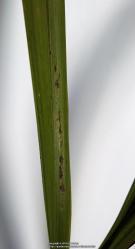
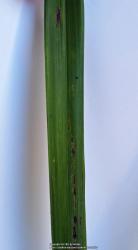
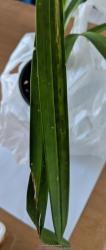

Another grower I have spoken with reported the ORSV can also cause v-shaped markings on the leaves. I have only seen this once on a plant (shown in the photo below), which tested positive as expected:
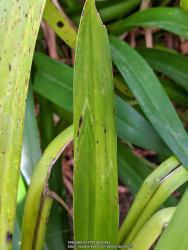 Orchid Fleck Virus (OFV) Symptoms
Orchid Fleck Virus (OFV) Symptoms
December 2019 finally provided me with a good example of OFV symptoms on a Cymbidium (this plant tested positive). The marks can become necrotic, but in this particular case most markings were just chlorotic in nature.
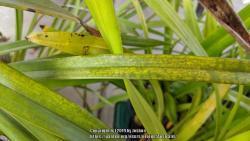
 Cymbidium Mosaic Virus (CymMV) Symptoms
Cymbidium Mosaic Virus (CymMV) Symptoms
April 2024: After many years and only a handful of positive cases, I have
finally come across plants showing symptoms. This was a particularly bad case:
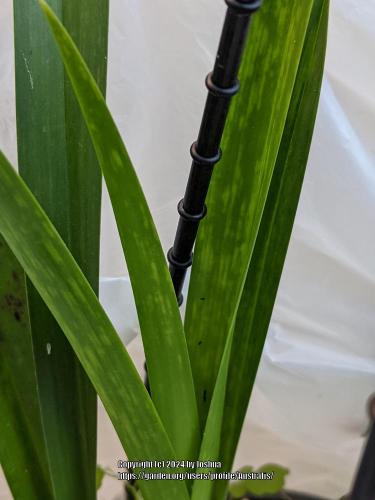
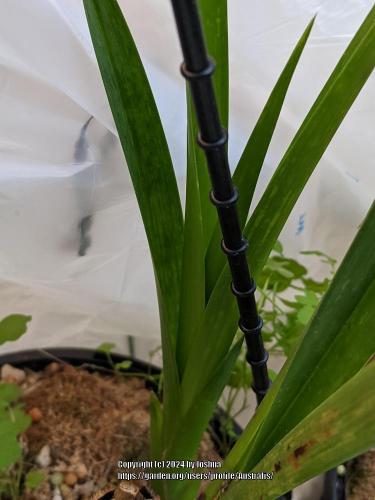
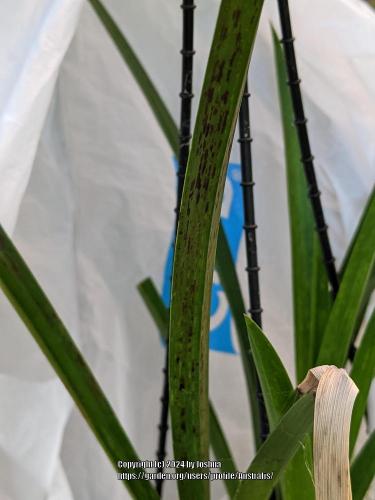
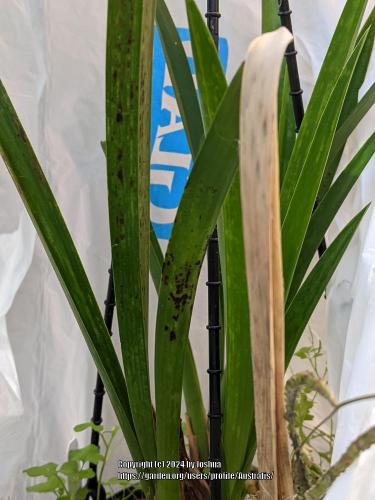 Multiple Viruses
Multiple Viruses
It is possible that a plant can be infected with multiple viruses. To date, I have only encountered this once and it was a plant of
Cym. iridioides that had both OFV and ORSV. Note the necrotic spots on multiple leaves, yet the majority of the foliage was still clean:


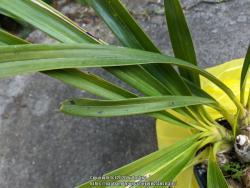 Unidentified Fungal Damage
Unidentified Fungal Damage
I have not identified the specific fungal infection here, but another grower did confirm that it was fungal in origin and the plant tested negative for viruses. It received two applications of a fungicide (Mancozeb) and all the new growths have been spotless.
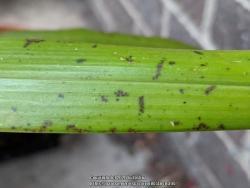
 Summary
Summary
I hope these photos help others to identify possible problems with their Cymbidiums! I am happy to try to answer questions where I can.

































